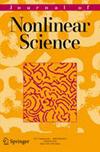Accurate Computations up to Breakdown of Quasi-Periodic Attractors in the Dissipative Spin–Orbit Problem
IF 2.6
2区 数学
Q1 MATHEMATICS, APPLIED
引用次数: 4
Abstract
Abstract We consider a Celestial Mechanics model: the spin–orbit problem with a dissipative tidal torque, which is a singular perturbation of a conservative system. The goal of this paper is to show that it is possible to maintain the accuracy and reliability of the computation of quasi-periodic attractors for parameter values extremely close to the breakdown and, therefore, it is possible to obtain information on the breakdown mechanism of these quasi-periodic attractors. The method uses at the same time numerical and rigorous improvements to provide (i) a very accurate computation of the time-1 map of the spin–orbit problem (which reduces the dimensionality of the problem); (ii) a very efficient KAM method for maps which computes the attractor and its tangent spaces (by quadratically convergent, low storage requirements, and low operation count); (iii) explicit algorithms backed by a rigorous a posteriori KAM theorem, which establishes that if the algorithm is successful and produces a small residual, then there is a true solution nearby; and (iv) guaranteed algorithms to reach arbitrarily close to the border of existence as long as there are enough computer resources. As a by-product of the accuracy that we maintain till breakdown, we study several scale-invariant observables of the tori used in the renormalization group of infinite-dimensional spaces. In contrast with previously studied simple models, the behavior at breakdown of the spin–orbit problem does not satisfy standard scaling relations which implies that the spin–orbit problem is not described by a hyperbolic fixed point of the renormalization operator.

耗散自旋轨道问题中准周期吸引子直至击穿的精确计算
考虑一个天体力学模型:具有耗散潮汐力矩的自旋轨道问题,该问题是一个保守系统的奇异摄动。本文的目的是证明在参数值非常接近击穿的情况下,保持准周期吸引子计算的准确性和可靠性是可能的,从而有可能获得这些准周期吸引子击穿机理的信息。该方法同时进行了数值和严格的改进,提供了:(1)非常精确地计算自旋轨道问题的时间-1图(降低了问题的维数);(ii)一种非常有效的地图KAM方法,它计算吸引子及其切线空间(通过二次收敛、低存储要求和低操作次数);(iii)由严格的后验KAM定理支持的显式算法,该定理表明,如果算法成功并产生小残差,则附近存在真解;(iv)只要有足够的计算机资源,保证算法可以任意接近存在的边界。作为我们在分解前保持精度的副产品,我们研究了用于无限维空间重整化群的环面的几个尺度不变的观测值。与以往研究的简单模型相比,自旋轨道问题的击穿行为不满足标准标度关系,这意味着自旋轨道问题不是由重整化算子的双曲不动点描述的。
本文章由计算机程序翻译,如有差异,请以英文原文为准。
求助全文
约1分钟内获得全文
求助全文
来源期刊
CiteScore
5.00
自引率
3.30%
发文量
87
审稿时长
4.5 months
期刊介绍:
The mission of the Journal of Nonlinear Science is to publish papers that augment the fundamental ways we describe, model, and predict nonlinear phenomena. Papers should make an original contribution to at least one technical area and should in addition illuminate issues beyond that area''s boundaries. Even excellent papers in a narrow field of interest are not appropriate for the journal. Papers can be oriented toward theory, experimentation, algorithms, numerical simulations, or applications as long as the work is creative and sound. Excessively theoretical work in which the application to natural phenomena is not apparent (at least through similar techniques) or in which the development of fundamental methodologies is not present is probably not appropriate. In turn, papers oriented toward experimentation, numerical simulations, or applications must not simply report results without an indication of what a theoretical explanation might be.
All papers should be submitted in English and must meet common standards of usage and grammar. In addition, because ours is a multidisciplinary subject, at minimum the introduction to the paper should be readable to a broad range of scientists and not only to specialists in the subject area. The scientific importance of the paper and its conclusions should be made clear in the introduction-this means that not only should the problem you study be presented, but its historical background, its relevance to science and technology, the specific phenomena it can be used to describe or investigate, and the outstanding open issues related to it should be explained. Failure to achieve this could disqualify the paper.

 求助内容:
求助内容: 应助结果提醒方式:
应助结果提醒方式:


